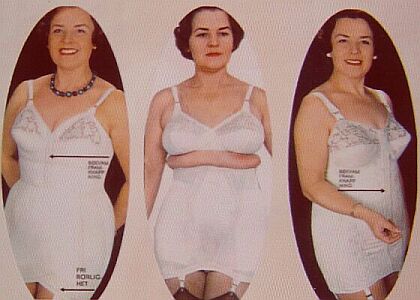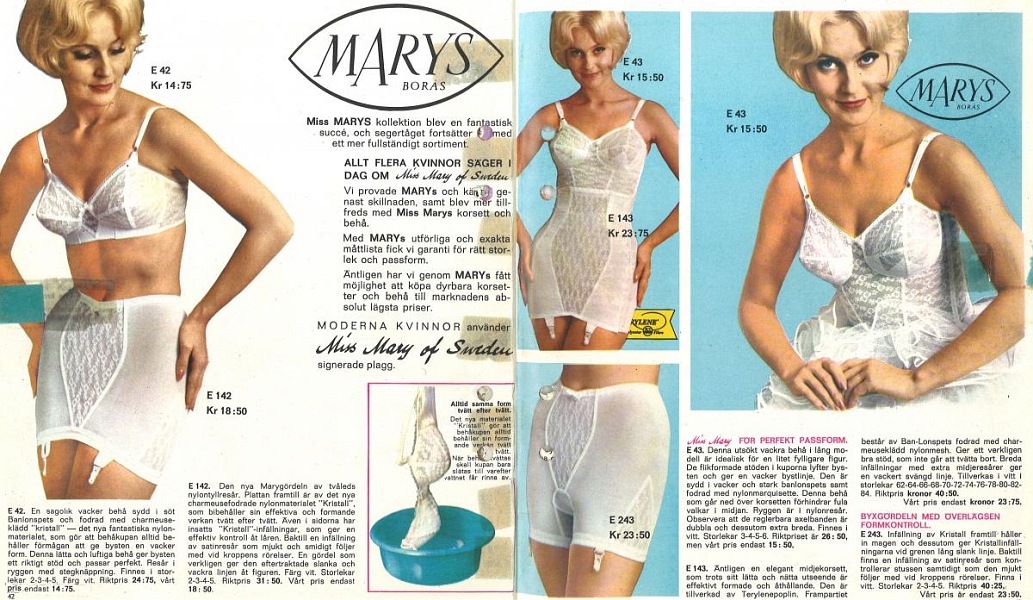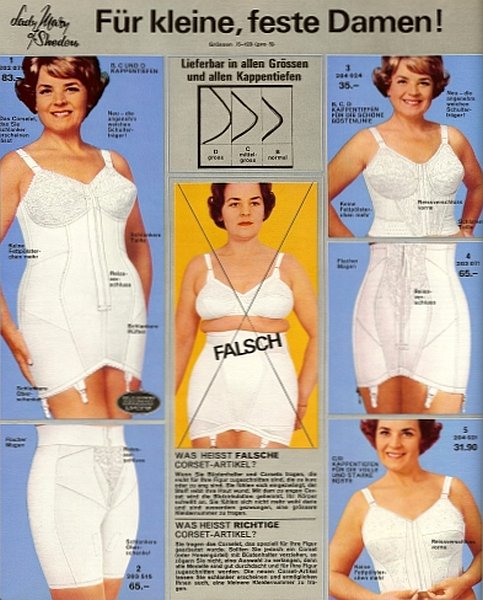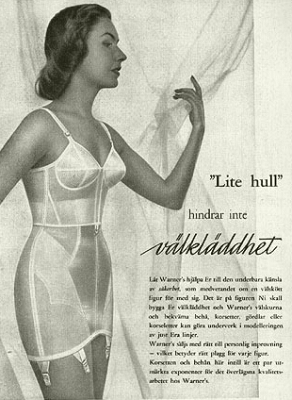
"
Scandinavia & Finland



Fox's and Kronan's versions of the attenuated waist
|
"
|
Scandinavia & Finland
|
Fox's and Kronan's versions of the attenuated waist
|
| I have never visited Denmark; however, my husband relates being
impressed at Copenhagen airport in 1973 by a stunning display in the
concourse of heavy satin girdles and corsets, all in brilliant white.
They appeared to be made-to-measure at some premises in Copenhagen (the Buddingsevij, near Lyngby). Certainly,
one of the very few Scandinavian corsets that I’ve ever
seen (it's Norwegian) makes full use of corset grade satin as its material of construction.
The use of the satin turns what would otherwise appear to be a very functional
surgical corset into an object of some elegance. The wearer of this piece would
certainly attain the shape required by the corset; there would be no other
option. Over the years, we have learned more. Spirella had a corset factories in Malmö and Copenhagen, but little history is available, even in the Spirella archives at Letchworth. It was only the kindness of a Swedish contact who gave us a whole host of advert from the 1950's that opened our eyes to the excellence of Swedish corsetry. Again, we were delighted to receive permission from a charming Danish lady, Marianne, to publish her recollections of the foundations of her youth. This is especially interesting and revealing since she spent time serving in a corset shop. Her story is related in Marianne's Tale.
|
|
|
|
|
|
Spirella in Sweden (has moved to its own page)
from
Marys Modehus of
|
The very elegant 'Miss Mary' girdle as sold by Ambrose Wilson in the UK in the 1970s. |
Miss Mary of Sweden was founded in 1957 in the Swedish textile capital of Borås by Ingemar Rydström, an innovative entrepreneur in the fashion business but it was his wife, Marwel 'Mary' Rydström, who brought the name of 'Miss Mary' to the corsetry trade. For the first few years, the company was called Marys Modehus and sold women’s ready-made clothing by mail order. Women’s undergarments weren’t launched until 1962, and they were an immediate success.
[September 2021: A correspondent informed us that Miss Mary was sued in the US due to claims that their girdles could take two inches off the waist. The story goes that Mary's husband tried on the girdle to prove that it really could do that. It must have been a very under-sized girdle to achieve such a reduction on the hard body of a man. It would have been easier to prove on Mary herself- Ivy]
|
|


A Marys catalogue from 1962 shows that Swedish women were very much into high-waisted girdles and had more access to panty-girdles than her British peers.





But why waste the photos of the models on just the Scandinavians, the Germans have small and 'solid' women too!


Not to mention the British as well and, rest assured, whether you wear a corselette, girdle or panty-girdle you too can achieve (whichever way you face) a blatantly modified figure. 'Falsch' indeed; never wear a short bra with a tight girdle Fraulein. Didn't Mutti teach you that?
It is a shame that the Swedes could not resist that cheesy 'before and after' photograph because the 'rätt' and 'fel' lady above looks far more realistic and convincing.



Miss Mary also made clothes and swimwear and, unlike Spirella's wretched 'Matchmakers' outfits, these Swedish confections really look rather stylish. Perhaps that's why Miss Mary is still trading whereas Spirella went to the wall over 30 years ago.

|
|
Even the normally straightforward Swedes couldn't help but bow to the 1970's trend to add unnecessary extras to a functional garment. Above from 1974, a huge tummy-band, with no less than four rows of hooks-and-eyes, has been added to an otherwise pretty corselette. Although this might just (on its tightest setting) have a small chance of reducing the burgeoning hips of the real Abba woman, it meant that a basic corselette now contained around 25 hooks (crotch, hips and front). |
|
|
|
Swedish corsets. Even the prosaic liberty bodice is rendered desirable by careful choice of materials.







Gorgeous satin foxline corselettes and girdles above.
The Swedish, apart from their home-grown products, imported and made under licence models from France, the USA and Britain. Even Twilfit supplied corsets for every possible Swedish shape and in case that wasn't enough, their (in-)famous rubber corsetry was at hand. What these rubber garments must have felt like on a cold winter's morning can not have been much fun. Certainly the model fails to raise a smile!


Swedish Advertisements
To quote Spirella "The
|
|
The advertisement on the left is one of the most elegant expressions of femininity that I've ever seen, however, you can wager a year's wages that the advertisement, the girdle and the company were created by a man! |
|




The girl with glasses was in great demand!


The James Bond era had a lot to answer for in advertising!
|
Of course, those experts of the high-waisted girdle, Warners, prospered in Sweden through extensive advertising (below). |
  |





Glossary
Svaréns S. Svaréns Trikåfabriks AB in Falköping, made Perforita.
Konfektions AB Fröja
( Swedish Spirella Malmö
Germa Stockholm, (Royal supplier) Opposite is shown a Germa girdle from the 1960's. Note the high waist that was required by the formal Swedish woman.
Kronan, Konfektionsaktiebolaget Karlson&Starck Göteborg. Rococo, Håll-In, Marquant, Midilastic. Bras Filmia
Kanters, Poirette (only import from USA) |
|
AB Corsettindusti, Borås Abecita, Fox, Cid, Abc, Little-X, Bras Little-wonder
The Abecita story dates back more than 70 years in the world of undergarments. Founded in Sweden in 1932 by Joel Åkerlund, he started a major corset factory in Borås; AB Corsettindusti manufacturing traditional ladies lingerie such as corsets, girdles, and brassieres. These products were and still are the company's primary focus. Previously the company had brands such as Cid, Abc and in the 1950's they also sold the famous girdle Little X. In the 1960's, the company acquired the brand Fox. In the beginning of the 1970's, Abecita manufactured the very famous one-size bra named the Little wonder. Since the 1980's, Abecita is now part of the Swegmark group.
Swegmark, Splendide, Lyxita, Criss-Cross
Arnbergs Korsettfabrik AB in Höganäs 1893, they made girdles and corselettes for Sweden but exported to Norway and UK. 1969 the nearly bankrupt business was sold to German Triumph. Graciette, Gracita, Graciella, Gracien Lady, Gracien Junior and Miss Grace were some of the trademarks.
Arnbergs Corsettfabrik AB was founded by Olof Arnberg in Höganäs, the farmer’s son who didn´t like the agricultural work. Instead, he opened in 1893 as 21-year old, tailor - dressmaker and draper´s shop in his own building at Köpmansgatan, Höganäs. It became the beginning of the corset factory that stood for 80 years.
In 1909, he built a new big factory at Storgatan. It became the biggest workplace for the Höganäs women. They made corsets with the names Grace, Graciform and Graciella that shaped woman bodies strongly, and the production became an important source of income too many women in this coal-mining and industrial community. Many girls started at 14 years old, as errand girls or cut-threads. The men worked in the delivery or department managers’ offices and by 1939, the number employed there rose to 635 persons, mainly women with 400 dressmakers.
When Arnberg started the company in 1891, he had help of a Danish tailor-cutter with the surname Lerche. Along with her they started to produce corsets. They had problems in the beginning, since glue used in the production pasted itself though onto the tailor´s dummys. In Copenhagen, he learnt of a method a copper dummy was used and shaping done with steam.
Arnbergs did not sell only products in Sweden, they had also an extensive export to Norway and England. Everything from the first tight-fitting corsets, flat corselettes in 1920, and later, models in more elastic materials with pointed breasts. Most of the raw material, 10,000 metres elastic fabric per week, was produced by the factory. Production grew to 50,000 garments each week. In the last years the production, in addition to corsets, corselettes, brassieres and girdles, was also extended to nightdresses.
When Olof Arnberg died in 1953, the youngest son, Lennart Arnberg, assumed the responsibility as MD for the company.
The halcyon period was in the 1950’s when the production increased during the son Lennart's management, from five to 25 millions Kroner, due to improved mechanical parking and marketing. At one point the turnover exceeded 70 millions Kroner.
When Arnberg’s Korsettfabrik started advertising for the first time in 1952, they begun with the big selling girdle Graciette. The anticipated selling 12,000 girdles but it became 60,000!
Then came the down- turn, despite traveling to America to gain new inspiration and purchase new materials. Arnbergs and every other corset makers’ biggest antagonist was the advent of the panty-hose (tights). In 1965, pantyhose came to Sweden and they rapidly became immensely popular. Now, nobody needs suspenders, corset or girdle to hold up the stockings. The skirts became also shorter and shorter. Thus did the corset sector face big losses each year and by 1967, only 186 employees were left on the factory.
In 1969, Arnberg sold the company to German Triumph and narrowly escaped bankruptcy. Lennart Arnberg would continue to work in Triumph’s factory in Turku for another 16 years.
Left in Höganäs were only stocks and offices. The factory building in the block along Storgatan was demolished 1982. As with so many towns, the characterful corset factory was replaced by faceless, anodyne real-estate offices and fast-food outlets. (Ironically, it would be these food parlours that provided modern woman with a desperate need for adequate corsetry, but with neither the knowledge nor the outlets to supply them any more – Ivy’s comment.)